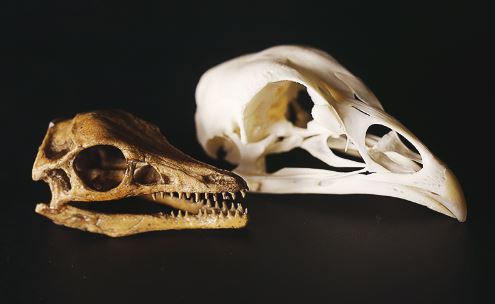
(R)Evolution! ‘Chickenosaurus’ and the Science of ‘Evo-Devo’
Occasionally in nature, animals are born with mutations that cause them to exhibit ancestral traits. For example, snakes can be born with legs, whales with tiny hindlimbs, horses with toes, and even humans with tails. These traits, which occur in both plants and animals, are called ‘atavisms’ or ‘evolutionary throwbacks’. Some animals also normally retain ancestral traits in a very reduced form, such as the pelvic structure in whales or the sightless eyes of the blind mole rat. These latter features are called ‘vestigial structures’. Both atavisms and vestigial structures tell us a lot about the evolutionary history of an organism.

In normal embryonic growth, the genes that control development are expressed (‘switched on and off’) in a set pattern so that different body parts or body systems develop in sequence. Developmental genes effectively instruct embryonic cells what body parts to grow where, as well as when to start and stop the growth process. The genes that control the basic development of all animals are surprisingly similar, having been conserved over millions of years. For example, the Pax6 gene controls the development of eyes across the animal kingdom, from fruit flies to humans.
However, not all developmental genes are in use in a given organism. Some developmental genes retained from earlier ancestral lineages are no longer expressed (‘turned on’) during normal development. An atavism or vestigial structure is a clue that a group of organisms still has an ancestral developmental gene whose expression has been ‘turned off’ or ‘turned down’, but which mutations can reactivate. For example, we know from the fossil record that ancestral snakes, such as the 95-million-year old Pachyrhachis, had hindlegs. The fact that snakes today are very occasionally born with legs suggests that all snakes still have those developmental genes – they’re just not normally expressed.
Atavisms are natural mutations, but developmental genes can also be experimentally manipulated in a lab situation. The newly developing field of evolutionary development, or ‘Evo-Devo’, searches for clues about evolution and phylogeny by exploring how changes in embryonic development produce the variation we see in adult animals. It’s now apparent that factors influencing embryonic development could lead to much more radical and rapid evolution than changes affecting adult organisms (as in Darwin’s classic model of natural selection). So, what can evo-devo tell us about our favorite group of prehistoric animals, the dinosaurs?
In 2006, researchers from the University of Wisconsin and the University of Manchester engineered a strain of mutant chicken that grew alligator-like teeth. The mutant gene in these chick embryos was in a developmental gene called Shh (this is short for Sonic Hedgehog; a Hox gene named for the famous speeding videogame character). Birds today don’t have teeth, but their ancestors, the theropod dinosaurs, did. By pinpointing which genes were turned on or off to cause the teeth develop, we can better understand how the evolutionary shift from toothed jaws to untoothed beaks may have occurred. By examining the patterning of limb development, evo-devo has also been useful in determining how bird wings developed from dinosaur hands. It can also hint at the developmental steps that lead to the shortening and eventually the loss of the dinosaurian tail (birds have tail feathers, but their skeletons are tailless).
Would it be possible to grow a dinosaur from a chick embryo by manipulating its developmental genes? The problem with manipulating developmental genes is that it often causes lethal mutations elsewhere in the animal. (The toothed chick embryos mentioned above never hatched for this reason). But could this issue be overcome? The jury is still out…
